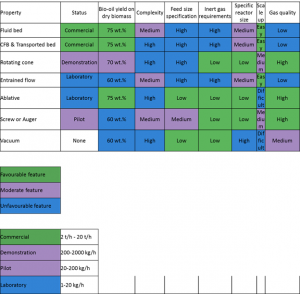General Overview of Pyrolysis
Pyrolysis is the thermal decomposition of materials in the absence of oxygen or when significantly less oxygen is present than required for complete combustion. It is the precursor of both the combustion and gasification processes. The products of biomass pyrolysis include bio-char, bio-oil, and gases (CH4, H2, CO, and CO2).
Pyrolysis methods can be ranked for feasibility by using many categories; these include: scale-up ability, status (commercial, demonstration, laboratory, pilot...), bio-oil yield, complexity, feed parameter specifications (moisture content, size…), and reactor size; even gas quality and inert gas requirements.
The chart below shows different characteristics of pyrolysis; the methods of pyrolysis can be thought in terms of availability for scale-up, complexity, etc. As one can imagine, certain methods are more advantageous than others. Feed flow rates for different scale up ranges are also shown below.

(Source: J. G. Speight, “Synthetic Fuels Handbook: properties, process, and performance”, McGraw-Hill, 236-239.)
References:
- J. G. Speight, “Synthetic Fuels Handbook: properties, process, and performance”, McGraw-Hill, 236-239.
- http://www.cleantechloops.com/biomass-pyrolysis-introduction/
- http://www.cleantechloops.com/biomass-pyrolysis/
- http://www.forestryencyclopedia.net/p/p1206
- http://biocharfarms.org/biochar_production_energy/
- http://peswiki.com/index.php/Directory:Dynamotive_Energy_Systems_Corporation_--_Fast_Pyrolysis